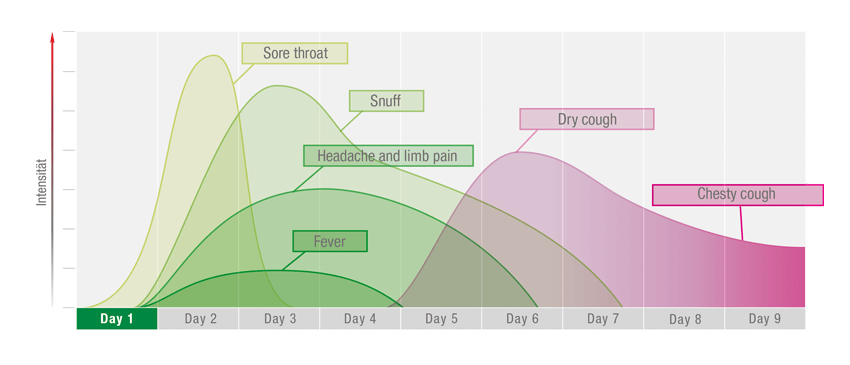There is no real protection against cold viruses - but you can treat those annoying symptoms of the common cold effectively

… you can treat those annoying symptoms of the common cold effectively
Colds are amongst the most common disorders. Cold viruses strike without remorse up to four times a year, in children even more often. Ten episodes of cold per year are quite normal in children. Since there are more than 300 different types of viruses, having weathered an infection does not confer enduring immunity. Although there is nothing one can do against the viruses causing colds, the cold symptoms can be treated quite well, thereby relieving patients tall and small!
Even if there is no real protection against cold viruses, you can treat the symptoms of the common cold effectively, so you can still enjoy your day despite the cold!

Apart from symptoms such as a runny nose and sore throat, and sometimes elevated temperature or fever, the symptoms of the common cold also include those annoying headaches, sore muscles and general aches and pains. One just feels battered. As the saying goes regarding the duration of a cold: "It's three days coming, three days staying, and three days leaving". Right! Colds bother us for just about one week - and in most cases it is gone after that.
First, the cold makes itself known with an itchy throat and slight shiver.
This is then compounded by a running nose. After one or two days the sore throat and running nose become worse. The marked swelling of the mucous membranes in the nose makes it difficult to breathe through the nose. At that point, quite often the patients also complain of headache and/or general aches and pains. Once the viruses have made it to the bronchi, the infection is aggravated on the fourth day by a wracking cough. Fever (or elevated temperature) also seen in many patients is another consequence of the infection.
Colds are passed from person to person by "droplet borne infection": People cough or sneeze at you. Each time this happens, millions of viruses are flung into the air, fine droplets are airborne for minutes, while the expelled viruses can persist there for hours. With each breath taken, the viruses then enter the airways of other people. Or you shake hands with someone suffering from a cold, and later on touch your mouth - just recently scientists have uncovered the hands as a huge reservoir for transmission!
Frequently washing your hands is the first step to be taken in preventing the spread. A strong immune system will take care of the rest - in other words, fighting off the remaining viruses. It is known that a weak immune system is much more likely to succumb to the common cold than a strong one! Especially during the cold season it is important to take in a sufficient amount of vitamins and to eat fresh fruits and vegetables several times a day! The immune system is also strengthened by adequate exercise and sleep.
Cold temperatures may increase the risk of the common cold: Cold temperatures weaken the body defenses by restricting the blood flow through the mucous membranes. Just having cold feet can be enough to signal the body "exposure", making it constrict the blood vessels.
Overly warm rooms may also promote colds: The warm air dries out the mucous membranes, the most important barriers against microorganisms, thus making them less impervious to germs. Now the viruses can penetrate there more easily and settle less impervious to germs. Now the viruses can penetrate there more easily and settle down.
Stress also weakens the body's defenses enormously: Lowering the stress level, for instance, by planning regular relaxation exercises during the day, helps to strengthen the immune system and the body's defenses!
- Drink at least two liters of water a day! This keeps the mucous membranes moist! Dry mucous membranes are the best breeding grounds for bacteria and viruses.
- Make sure to exercise enough, best outside in fresh air! This is also true for the cold season - do not forget to put on warm clothes! When going outside in the fall and winter, this should include a scarf, gloves, and a cap. A lot of heat is lost in winter time, especially from the head.
- Make sure to get enough and restful sleep! Studies have shown that enough sleep protects against infection! The amount of sleep needed differs from person to person, usually somewhere between six and ten hours. Bed rest is also a cornerstone in the treatment of colds, the flu, and other infectious diseases.
- Balanced diet! This also includes a sufficient intake of vitamins. Vitamin products from the drugstore put you on the safe side.
- Exercise the immune system with hot & cold showers, sauna, and endurance training.
- Wash your hands several times a day.
- Air the rooms regularly and prevent the air from becoming dry.
- If possible, avoid large gatherings of people during fall and winter. This is where a multitude of cold viruses are lurking!
In case you cought a cold after all, the following steps can help you to get relief!
Enough rest
Enough sleep
Proven household remedies such as cold packs for the throat and/or calf, inhalation…
Fresh air
Enough humidity in rooms
No smoking under any circumstances because its noxious substances also harm the mucous membranes already under attack.
- the cold lasts for more than ten days.
- there is high fever or if fever and pain persist for more than two days despite medication.
- the phlegm expelled by coughing has a yellowish-green color. In this case there might be bacterial involvement which, in some cases, should be treated with antibiotics.
- the throat becomes quite painful or if the pain lasts for more than three days.
- the tongue or the mucous membranes of the throat display white to yellow coatings because this might signal a fungal infection.
- the tonsils display stippling spots.
In case of the common cold the main symptoms are running nose, painful throat, and headache. This disease may appear all year long. Influenza, better known as the flu, on the other hand only appears during times of an epidemic when the influenza viruses are circulating. In other words, usually there is no flu epidemic during the summer. In real influenza the disease sets in rather rapidly and severely and is accompanied by high fever which quite often does not react at all, or just poorly, to fever relief measures. Another strong indication is severe muscle pain.
It is important to start treatment quickly because otherwise the flu viruses can invade the body much more easily, and vital time is lost fighting them.
Infectious diseases such as the flu are transmitted from person to person. Because of this risk of contagious infection the WHO (World Health Organization) recommends vaccination for everyone, in order to protect everyone and stop the disease from spreading. Vaccination is recommended especially in children, the elderly, pregnant women, and patients with an underlying disorder or at risk for complications. Since the influenza viruses are extremely agile in changing, each year other variants of the viruses are passing through, and therefore the vaccination should be repeated on an annual basis.